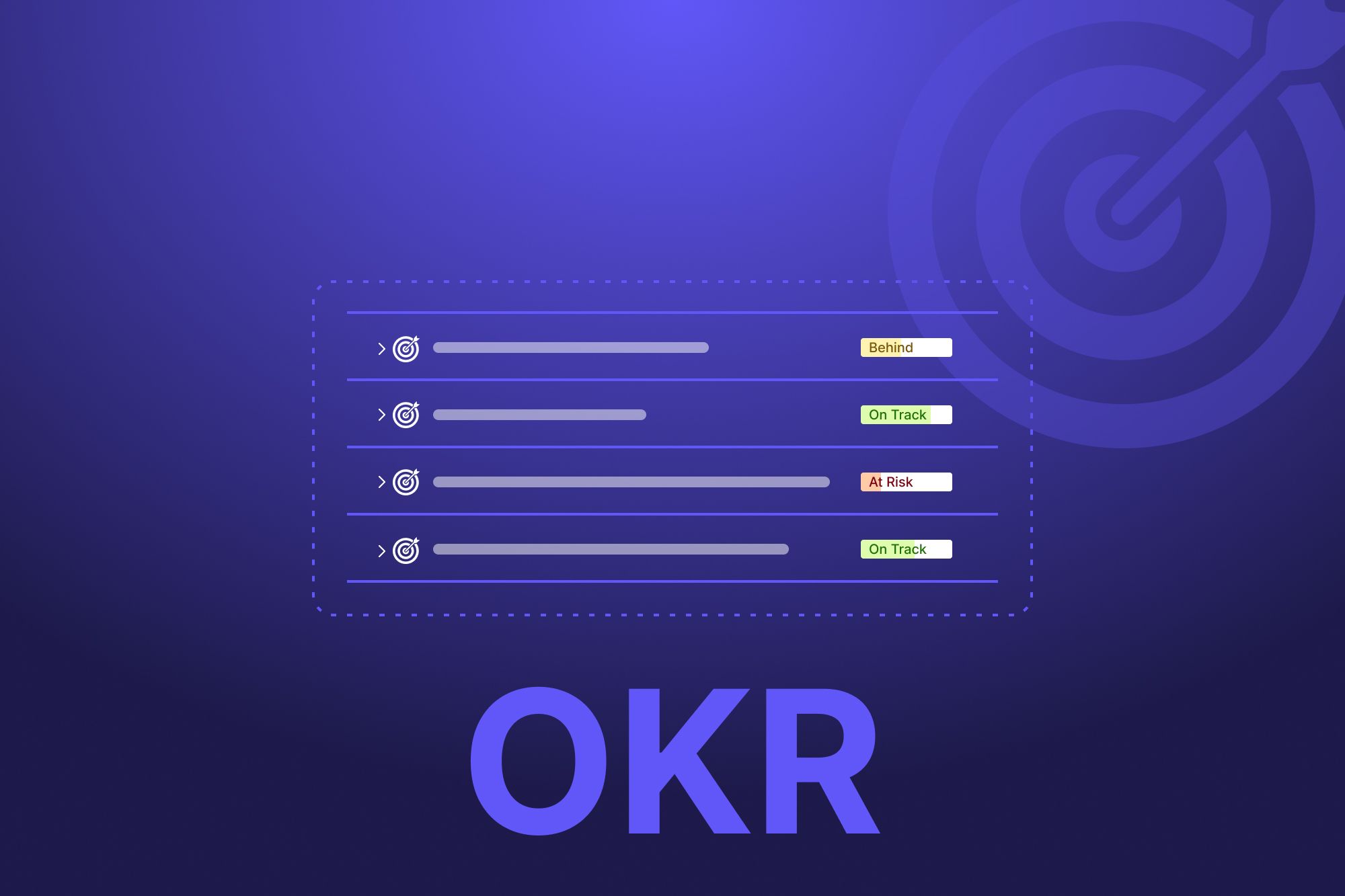Engineering OKRs: A comprehensive guide for engineering leaders

The importance of performance management in organizations cannot be downplayed. With a good performance management system in place, leaders can make sure employees understand what they need to work towards. One critical aspect of performance management is setting and measuring strategic goals. This is where engineering OKRs (Objectives and Key Results) come into play. In this blog, we'll explore the concept of engineering OKRs, how they can benefit your org, and how you should go about setting results-driven OKRs.
What are engineering OKRs?
OKRs (Objectives and Key Results) are an effective goal-setting framework that leaders can use to keep track of the progress made by teams toward strategic business goals. Objectives are high-level, qualitative statements that describe the desired outcomes, aiming to inspire and motivate the team. Key results, on the other hand, are quantitative indicators that demonstrate progress toward an objective.
OKRs are a great way to communicate what you want your team to accomplish and encourage them to attain measurable goals. The system originated in the 1970s and is now used by leading organizations like Netflix, Oracle, and Google.
While OKRs are beneficial to a range of industries, how usable are they in the world of software development? Well, for starters, OKRs were developed at Intel - an engineering-centric organization, and they’ve been used in software engineering for decades. The only difference is that organizations mostly use OKRs to meet financial goals, but engineering OKRs, on the other hand, prioritize technical objectives like improving software.
Engineering OKRs are designed specifically for the needs of engineering teams and used by engineering leaders to define, measure, and track engineering goals. With engineering-centric OKRs, you get a clear and measurable way to track progress and success. This helps ensure the team is moving in the right direction and progressing toward its goals. Setting engineering OKRs also ensures your engineering team is focusing their efforts on the most important projects.
Difference between OKRs and KPIs
You may have heard OKRs and KPIs being used interchangeably, but in reality, they are polar opposites. OKRs are all about setting strategic goals that your engineering team can accomplish. KPIs (Key Performance Indicators) are a way for engineering managers to track team performance based on a project. Simply put, while OKRs focus on certain tasks within a specific time, KPIs measure the activities during that time.
The truth is, in software development, you need both OKRs and KPIs to gain a well-rounded perspective on your day-to-day engineering operations. Setting OKRs will help you draft a realistic timeline, and setting KPIs will enable you to monitor team performance to see areas where things aren’t going according to plan.
Importance of engineering OKRs
OKRs are a great (and somewhat inexpensive) way to set a common goal for your engineering org. By embracing engineering OKRs, you can elevate your team's performance, deliver better results, and contribute more effectively to the success of your organization. Here are some of the other benefits of engineering OKRs:
- Alignment at the individual, team, and organizational level
- Improved team focus and productivity
- Higher transparency across all levels
- Clarity on goals and targets
- More accountability
- Fostering an innovative team culture with continuous improvement
- Increased collaboration and adaptability
How to (successfully) set engineering OKRs
Merely setting OKRs isn’t a guarantee of success. Engineering leaders must ensure the goals align with their team’s priorities and the company’s overall vision. While there’s no one-size-fits-all approach to setting OKRs, there are some common to-dos you can follow while creating OKRs for your engineering org:
Be S.M.A.R.T.
You may have heard of the SMART approach to goal-setting: Specific, Measurable, Achievable, Relevant, and Time-bound. It helps create clear, concise, and actionable goals, making individuals or organizations more likely to achieve them. Here’s how you can use the SMART framework while creating OKRs -
- Specific: The goals you set should be well-defined and clear, addressing the who, what, where, when, and why. Your team will find it easy to achieve distinct objectives rather than unclear ones.
- Measurable: Ideally, objectives and key results should be quantifiable. That way, you can track progress easily.
- Achievable: You should set ambitious yet realistic and achievable goals. Setting doable goals helps to maintain motivation and avoid frustration or disappointment for your team.
- Relevant: Objectives should align with your organization’s business goals and plans, ensuring they contribute meaningfully to the desired outcome. You should also consider factors like the availability of resources and constraints.
- Time-bound: Give your goals a defined timeline with a start and end date to create a sense of urgency and motivate team members to achieve results within a specific period.
Less is more
You know the saying, “excess of anything is bad”? That proverb extends to OKRs as well. If you’re a new manager or new to setting OKRs, it’s natural to get swept away and go overboard. However, this approach may lead to confusion or even burnout. That’s why it’s advisable to pick only a couple of objectives (3-5 maximum) and set around three key results per objective.
Involve team members
Your team will be working towards achieving results, so it makes sense to include them in the goal-setting process. This way, you can keep in mind your team members' individual skill sets and capabilities and leverage their strengths to achieve targets.
By making OKRs a collaborative process, you can also get feedback from your engineers on how they want to work towards the objectives. In turn, including them in the decision-making process makes them feel a part of something big and pushes them to take ownership.
Review and learn
Setting OKRs isn’t a one-and-done deal. To ensure they’re working, you need to go in and review them from time to time and tweak them accordingly. Doing so will help you identify areas that need improvement and let you see if your team is prioritizing relevant tasks. Regular check-ins and adjustments will also help ensure your OKRs remain relevant and effective. Then, you can use these insights to set up OKRs the next time around.
Engineering OKRs examples
Below are some real-life, modern-day examples of engineering OKRs that you can incorporate into your org:
1. Objective: Improve developer productivity
- KR1: Reduce average bug resolution time by 30%.
- KR2: Decrease code review time by 25%.
- KR3: Implement automation to save 15% of time spent on repetitive tasks.
- KR4: Increase code commit frequency by 20%.
2. Objective: Increase automation in the software development process
- KR1: Automate 80% of the deployment process within the next quarter by setting up and implementing a CI/CD pipeline.
- KR2: Reduce the average deployment time by 50% over the next three months by streamlining and automating manual tasks.
- KR3: Achieve a 90% success rate for automated deployments, with no manual intervention required, within the next six months.
3. Objective: Improve code quality
- KR1: Reduce the average number of critical and high-priority bugs by 40% within the next quarter.
- KR2: Increase unit test coverage to 85% across all critical modules by the end of the quarter.
- KR3: Implement mandatory code reviews for all feature branches, achieving a 95% adherence rate within the next three months.
4. Objective: Enhance user experience
- KR1: Decrease the average page load time by 30% across all key pages within the next three months.
- KR2: Identify and implement at least three new user-requested features or improvements by the end of the next quarter.
- KR4: Ship at least three new user-requested features or improvements by the end of the quarter.
5. Objective: Improve stability during product releases
- KR1: Cut hotfixes in half within the first month after the next three releases.
- KR2: Maintain 99.5% uptime for all apps during the first month of the next three releases.
- KR3: Keep the rollback rate below 5% by enhancing testing in this quarter.
Conclusion
The responsibilities of an engineering manager are multi-layered as they have to consider their team, the leadership, and customers during the decision-making and goal-setting process. Of course, doing so isn’t a walk in the park, but being SMART about it can take you a long way. It also helps to have an engineering analytics tool like DevDynamics to gather practical data that can help you set productive and meaningful engineering OKRs.
Ready to drive engineering success?

